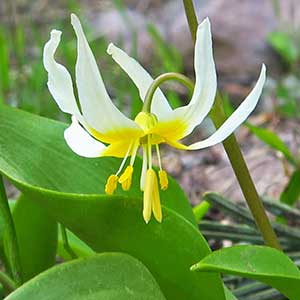Erythronium klamathense
Erythronium californicum
Klamath fawn-lily
California fawn-lily
slender, 25–40 mm.
ovoid, 35–60 mm, sometimes producing sessile offsets.
6–17 cm;
blade green, lanceolate to narrowly elliptic, ± folded along midvein, margins entire to wavy.
7–18 cm;
blade distinctly mottled with irregular streaks of brown or white, oblong to narrowly ovate, margins usually wavy.
6–20 cm.
± reddish, branched well above leaves when flowers more than 1, 10–30 cm.
1–3-flowered.
1–3-flowered.
tepals 2/3 or more white, with yellow zone at base, ± pinkish in age, broadly lanceolate, 20–35 mm, inner with small auricles at base;
stamens 8–14 mm;
filaments white, slender;
anthers ± yellow;
style white, 4–9 mm;
stigma ± unlobed.
flowering individuals generally abundant in populations;
tepals white to cream, base yellow and often banded with brown or red, ± narrowly ovate, 25–40 mm, inner with small auricles at base;
stamens 12–25 mm;
filaments ± white, linear, slender, less than 0.8 mm wide;
anthers white to cream;
style ± white, 10–14 mm;
stigma unlobed or with lobes less than 2 mm.
narrowly obovoid, 2–5 cm.
obovoid, 3–6 cm.
= 24.
= 24.
Erythronium klamathense
Erythronium californicum
Forms intermediate with Erythronium citrinum and E. multiscapideum are sometimes seen where ranges overlap.
(Discussion copyrighted by Flora of North America; reprinted with permission.)
